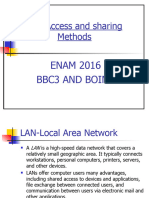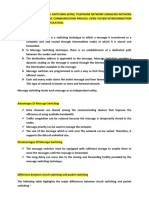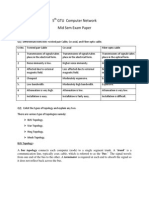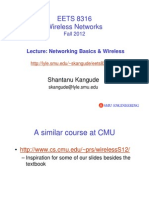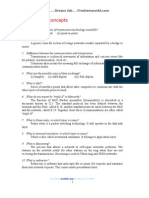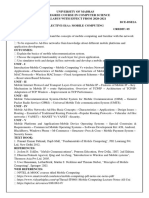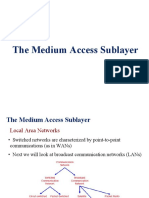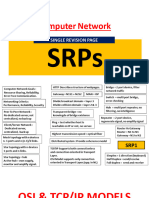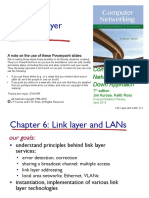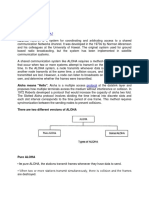Mobile Computing
Uploaded by
Drishya MitraMobile Computing
Uploaded by
Drishya MitraSuggestions
11 January 2024 08:35
1. Define FDMA,TDMA,CDMA. 1. Define the term topology with examples.
○ FDMA is the process of dividing one channel or bandwidth into multiple individual A network topology is the physical and logical arrangement of nodes and
bands, each for use by a single user. Each band or channel is wide enough to connections in a network. Nodes usually include devices such as switches, routers
accommodate the signal spectra of the transmissions to be propagated. The data to and software with switch and router features. Network topologies are often
be transmitted is modulated onto each subcarrier, and all of them are linearly mixed represented as a graph.
together. The best example of this is the cable television system. Network topologies describe the arrangement of networks and the relative
location of traffic flows. Administrators can use network topology diagrams to
determine the best placements for each node and the optimal path for traffic
flow. With a well-defined and planned-out network topology, an organization can
more easily locate faults and fix issues, improving its data transfer efficiency.
2. Mention the components of Networking.
○ TDMA is a digital technique that divides a single channel or band into time slots.
Each time slot is used to transmit one byte or another digital segment of each signal 3. Differentiate between Router, Switch, Hub and Gateway in terms of OSI model.
in sequential serial data format. This technique works well with slow voice data
signals, but it’s also useful for compressed video and other high-speed data. A good S. No Hub Switch Router
example is the widely used T1 transmission system, which has been used for years 1. Hub belongs to layer 1 Switch belongs to Router belongs to layer 3
in the telecom industry. of an OSI model that layer 2 of an OSI of an OSI model that
means it is a physical model that means it means it is a network layer
layer device. is a data link layer device.
device.
2. Hub prefers half-duplex Switch prefers full- It is full duplex in nature.
transmission method. duplex transmission
method.
○ CDMA is another pure digital technique. It is also known as the spread spectrum 3. It functions based on It functions based It functions based on IP
because it takes the digitized version of an analog signal and spreads it out over a broadcasting. on MAC addresses. addresses.
wider bandwidth at a lower power level. This method is called direct sequence 4. Hub is commonly used A switch is used by A router is utilized by LAN
spread spectrum (DSSS) as well (Fig. 4). The digitized and compressed voice signal in to link components of a LAN. as well as MAN.
serial data form is spread by processing it in an XOR circuit along with a chipping LAN
signal at a much higher frequency. In the CDMA IS-95 standard, a 1.2288-Mbit/s 5. Hubs are not smart A Switch is a smart Routers are basically tiny
chipping signal spreads the digitized compressed voice at 13 kbits/s. One of the gadgets because they and wise device as computers that accomplish
most well-known examples of CDMA technology is the 3G network used by Verizon pass on everything it gives a message a variety of intelligent jobs.
and Sprint in the United States. obtained on one to a specific device They can also help in
connection to all other by scanning the building address tables that
connections. address. support routing decisions.
6. In a hub, we need a Here also, we It demands a minimum of
single network to require a single two networks to connect.
connect. network to connect.
7. It is inexpensive as It is an expensive It is a more expensive
compared to switch device than a hub. device than a hub and
and router. switch.
2. What is PSTN?
PSTN is short for Public Switched Telephone Network. PSTN refers to the traditional 4. Explain the features of each layer of OSI level.
telephone system used for voice-oriented communications. It carries your voice calls 5. Explain the features of each layer of TCP layer.
from your telephone through the network to the recipient's phone. It consists of • Application layer
multiple interconnected carriers to connect people through standard phone numbers ○ Application-layer helps you to identify communication partners, determining
reliably. resource availability, and synchronizing communication.
It works by using underground copper wires that are hardwired from homes and ○ It allows users to log on to a remote host
businesses to switching centers—where the phone calls are connected. ○ This layer provides various e-mail services
The PSTN is also known as the Plain Old Telephone Service (POTS) because it’s ○ This application offers distributed database sources and access for global
well-established and straightforward. It doesn’t rely on an internet connection, and it information about various objects and services.
even works during power outages. However, the plain old service comes with plain • Transport layer
old functionality: you can make and receive voice calls, but that’s about it. The PSTN
○ It divides the message received from the session layer into segments and
does not support features like conference calling, call recording, or intelligent call
numbers them to make a sequence.
routing.
○ Transport layer makes sure that the message is delivered to the correct
process on the destination machine.
○ It also makes sure that the entire message arrives without any error else it
3. Explain the salient features of PSTN?
should be retransmitted.
○ Subscribers can be connected by entering telephone numbers
• Internet layer
○ The existing connections are primarily used to transmit speech information
○ It transmits data packets to the link layer.
○ After hanging up the connection is closed and the resources used become available
○ It routes each of the data packets independently from the source to the
to other subscribers
destination, using the optimal route.
○ It doesn’t rely on an internet connection
○ It reassembles the out-of-order packets when they reach the destination.
○ it even works during power outages
○ It handles the error in transmission of data packets and fragmentation of data
packets.
• Network access layer
4. What is LATA? Explain the types of LATA.
○ A network layer is the lowest layer of the TCP/IP model.
LATA stands for Local Access and Transport Area. A LATA is a contiguous
geographic area. ○ A network layer is the combination of the Physical layer and Data Link layer
Designated by the federal government, Local Access and Transport Areas defined in the OSI reference model.
(LATAs) are boundaries that dictate which telephone service providers can offer ○ It defines how the data should be sent physically through the network.
local and long-distance services to customers within their regions. ○ This layer is mainly responsible for the transmission of the data between two
LATAs organize phone companies' networks so those who need reliable devices on the same network.
communication solutions can access them no matter where they live. ○ The functions carried out by this layer are encapsulating the IP datagram into
○ IntraLATA Calls - IntraLATA refers to a telephone call or circuit which does not cross frames transmitted by the network and mapping of IP addresses into physical
a LATA boundary. IntraLATA communications require the assistance of the Local addresses.
Exchange Carrier, but not the IXC (InterXchange Carrier). ○ The protocols used by this layer are ethernet, token ring, FDDI, X.25, frame
Because IntraLATA long distance is not subject to the same competitive market relay.
forces as InterLATA (and interstate) long-distance, IntraLATA long-distance calls From <https://www.javatpoint.com/computer-network-tcp-ip-model>
normally cost more.
○ InterLATA calls refer to those that originate within one LATA and terminate in
another. It is this type of call that is most referred to as a “long-distance” call.
Because InterLATA communications do cross LATA boundaries, they do require the 6. Explain the IP-Header frame format with the help of a diagram.
help of an IXC (InterXchange Carrier) to be completed.
5. What is the principle of frequency of reuse?
In frequency reuse, individual frequency bands are shared by multiple base stations
and users. This is possible by ensuring that one subscriber or base station does not
interfere with any others. This is achieved by controlling factors such as transmission
power, base station spacing, antenna height, and radiation patterns.
6. Differentiate between 3G,4G,5G,6G.
Comparis 2G 3G 4G 5G 6G
on
Introduced 1993 2001 2009 2018 2022
in year
Speed 1Mbps 21.6Mbps 1 Gbps 10gbps 1tbps
Frequency 900 to 850 to 700 MHz to 2.6 24 GHz to 66 30 GHz to 3
1800 MHz 2100 MHz GHz GHz THz
MOBILE COMPUTING Page 1
Introduced 1993 2001 2009 2018 2022
in year
Speed 1Mbps 21.6Mbps 1 Gbps 10gbps 1tbps
Frequency 900 to 850 to 700 MHz to 2.6 24 GHz to 66 30 GHz to 3
1800 MHz 2100 MHz GHz GHz THz
Latency 300–1000 100–500 50 ms 5 ms less than 1
ms ms ms
Capacity 4G can support 5G can support 6G will 7. Explain the TCP-Header frame format with the help of a diagram.
up to 10,000 up to 1 million increase the
devices per devices per capacity to up
square square to 10 billion
kilometer kilometer devices per
square
kilometer
Core PSTN Packet Internet Internet Internet
network network
Use-cases 2G enabl 3G finds 4G enabled 5G enables 6G will enable
ed text- applicatio high-definition autonomous smart
based ns video vehicles, the societies,
data to be in wireless streaming, Internet of holographic
transmitte voice mobile gaming, Things (IoT), telepresence,
d via short telephony, and social smart cities and augmented
messagin mobile media remote reality (AR),
g service Internet healthcare virtual reality
(SMS) access, (VR), artificial
fixed intelligence
wireless (AI) and
Internet mobile edge Source port address is a 16 bit field that defines port number of application
access, computing program that is sending the segment.
video Destination port address is a 16 bit field that defines port number of application
calls, and program that is receiving the segment.
mobile Sequence number is a field of 32 bit that will define the number assigned to data
TV. first byte contained in segment.
Acknowledgement number is a 32 bit field that describe the next byte that
receiver is looking forward to receive next from sender.
7. Explain the role of mobile communication for network security prospects Header Length (HLEN) is a field of 4 bit that specify the number of 4 byte words in
TCP header. The header length of TCP header can be between 20 to 60 bytes.
Reserved is a field 6 bit that are reserved for future use.
8. Draw GSM architecture and show each components Control bits are 6 different independent control bits or flags in this field.
There are six in control field:
URG: Urgent pointer
ACK: Acknowledgement number
PSH: Push request
RST: Reset connection
SYN: Sequence number Synchronization
FIN: Connection termination
Window Size is a 16-bit field that defines the size of the window of sending TCP in
bytes.
Checksum, 16-bit field contains checksum and used for error detection.
Urgent pointer is a 16 bit field .This flag is set when there is urgent data in the
data segment.
Options and padding can be up to 40 bytes field for optional information in TCP
header.
8. Explain the UDP-Header frame format with the help of a diagram.
UDP packets have a fixed size header of 8 bytes which is divided into four
parts -
1. Source port address: It defines source port number and it is of 16 bits.
2. Destination port address: It defines destination port number and it is of 16 bits.
3. Total length: This field is used to define the total length of the user datagram
which is sum of header and data length in bytes. It is a 16-bit field.
4. Checksum: Checksum is also 16 bit field to carry the optional error detection
data.
9. What is Aloha?
9. What do you mean by channel assignment and grade of services? It is intended for using in a wireless LAN, but it can also be used to transmit data
It means to allocate the available channels to the cells in a cellular system. When a over a shared medium. When a data frameset is available for transmission any
user wants to make a call request then by using channel allocation strategies their station can transmit data across a network simultaneously using this method.
requests are fulfilled. It does not necessitate the use of carrier sense.
During the transmission of data through multiple stations, collisions and data
Grade of service is the probability of a call in a circuit group being blocked or frames may occur.
delayed for more than a specified interval, expressed as a vulgar fraction or decimal In Aloha, there is an acknowledgment of the frames. As a result, no collision
fraction. This is always with reference to the busy hour when the traffic intensity is detection is possible.
the greatest. Grade of service may be viewed independently from the perspective of It necessitates data retransmission after a set time.
incoming versus outgoing calls, and is not necessarily equal in each direction or
between different source-destination pairs.
10. Explain the mechanism of slotted Aloha.
Slotted ALOHA was invented to improve the efficiency of pure ALOHA. In
○ write down two differences between Channel assignment and Grade of Services?
slotted ALOHA we divide the time into slots of Tfr s(time to send each fixed size
frame) and force the station to send only at the beginning of the time slot. Figure
12.5 shows an example of frame collisions in slotted ALOHA.
10. What is VOIP?
Voice over Internet Protocol (VoIP), is a technology that allows you to make voice
calls using a broadband Internet connection instead of a regular (or analog) phone
line. Some VoIP services only allow you to call other people using the same service.
While others provides with the ability to call anyone who has a telephone number,
including local, long-distance, mobile, and international numbers. Additionally, while
some VoIP services only work over your computer or a specialized VoIP phone,
other services allow you to use a traditional phone connected to a VoIP adapter.
○ Features:
i. Cost-saving: Voice over Internet Protocol (VoIP) provides a cost -effective and
reliable alternative to traditional phone services, offering lower call rates and the
ability to make calls over the Internet.
ii. Integration: VoIP technology allows for the integration of multiple communication
channels in a single platform, such as phone calls, video conferencing, and 11. Explain the mechanism of pure Aloha.
MOBILE COMPUTING Page 2
○ Features:
i. Cost-saving: Voice over Internet Protocol (VoIP) provides a cost -effective and
reliable alternative to traditional phone services, offering lower call rates and the
ability to make calls over the Internet.
ii. Integration: VoIP technology allows for the integration of multiple communication
channels in a single platform, such as phone calls, video conferencing, and 11. Explain the mechanism of pure Aloha.
instant messaging. The original ALOHA protocol is called pure ALOHA. This is a simple, but elegant
iii. Mobility: VoIP allows for greater mobility, as users can make calls and access protocol. The idea is that each station sends a frame whenever it has a frame to
their voicemail from virtually anywhere with an internet connection. send. However, since there is only one channel to share, there is the possibility of
iv. Ease of use: VoIP is designed to be user-friendly and easy to set up and use, collision between frames from different stations. Figure 12.3 shows an example of
making it accessible to a wide range of users. frame collisions in pure ALOHA.
v. Scalability: VoIP can be scaled to meet the demands of a business, making it a
flexible and adaptable communication solution.
vi. Quality – VoIP provides enhanced voice quality, often with HD audio, allowing for clear
and crisp communication.
vii. Security – VoIP technology can offer increased security measures, such as encryption
and access control, helping to protect sensitive business information and data.
11. Differentiate between ICMP & IGMP.
12. Explain the mechanism of CSMA-CA.
• Flow diagram of CSMA/CA
12. What is hand-off? Explain the types of hand-offs.
When a mobile moves into a different cell while a conversation is in progress, the
MSC automatically transfers the call to a new channel belonging to the new base
station. This procedure is called handoff.
The handoffs are of following types:
• Hard Handoff:
○ The definition of a hard handover or handoff is one where an existing connection
must be broken before the new one is established.
○ Hard handoff allocate different frequency of user.
○ In hard hand off a handset always communicates with one base station at any given
time
○ Hard handoff is typically used in TDMA and FDMA systems.
○ Hard handoff is not very complicated.
○ Since the radio link between the BS and the handset is broken before it is connected
in hard handoff, the link transfer may fail due to long network response time even if
radio channels are available in the new BS.
• Soft handoff:
○ Soft handoff is defined as a handover where a new connection is established before 13. Explain the mechanism of CSMA-CD.
the old one is released. CSMA/CD means CSMA with Collision Detection. In CSMA/CD, whenever a
○ Soft hand off allocate same frequency. station transmits data-frame it then detects the medium to admit the state of the
○ In soft handoff a handset may connect up to three or four radio links at the same transmission that whether it is profitably transmitted or failed. If the transmission
time. succeeds, then it produces the successive frame otherwise it resends the
○ Soft handoff used in CDMA and some TDMA systems. formerly failed data frame.
○ Soft handoff is more complicated than hard handoff.
○ On the other hand, soft handoff degrades channel availability because a handset
may consume multiple radio channels.
• Delayed handoff
○ A Delayed handoff is a two hand off level algorithm. It provides more opportunity for
a successful hand off.
○ The MTSO always handles the handoff first and the originating calls second. If no
neighboring cells are available after the second handoff level is reached, the call
continues until the signal strength drops below the threshold level then the call is
dropped.
○ Lower handoffs help in handling call processing more adequately.
○ It makes the hand off occur at the proper location and eliminates possible
interference in the system.
• Mobile Assisted Handoff (MAHO)
○ In Mobile Assisted Handoff (MAHO) every mobile station measures the received Let, node A start forwarding the frame to node D at time ti, then node A monitors
power from surrounding base stations and continually reports the results of these the medium up to time(ti + Tfr). If the collision signal reaches node A within ti to (ti +
measurements to the serving base station. tfr) then it can detect collision.
○ A handoff is initiated, when the power received from the base station of a Consider the transmitted signal reaches node C at time tc but node C says the
neighboring cell begins to exceed the power received from the current base station medium for frame transmission at time tj. At time tj medium is idle w.r.t node C
by a certain level or for a certain period of time. so It stats forwarding frame which may collide with the signal forwarded node A.
○ In MAHO method call handed over between base stations is much faster than first At the time tk node A receives that collision occurs so it stops forwarding the frame.
generation analog systems .As handoff measurements are made by each mobile . Similarly, at the time, tc node C recognizes that collision occurs.
MSC no longer constantly monitors signal strengths. MAHO is particularly suited for To detect collision necessary conditions will be,
microcellular environments where handoffs are more frequent. During the course of Tfr 2Tp
a call, if a mobile moves from one cellular system to a different cellular system or, L/B 2Tp
controlled by a different MSC, an intersystem handoff becomes necessary. or, L B * 2Tp
○ An MSC engages in an intersystem handoff when a mobile signal becomes weak in
a given cell and the MSC cannot find another cell within its system to which it can • Flow diagram of CSMA/CD
transfer the call in progress.
13. Explain the components of cellular network.
14. Mention features of DHCP with its frame format.
DHCP (Dynamic Host Configuration Protocol) is a network management protocol
used to dynamically assign an IP address to any device, or node, on a network so it
can communicate using IP.
DHCP overcomes the static configuration problem of BOOTP. In BOOTP the binding
between the physical and IP addresses is static and fixed in a table until changed by
the administrator. DHCP has been devised to provide static and dynamic address
allocation that can be manual or automatic.
○ Static Address Allocation: In this capacity DHCP acts as BOOTP does. It is
backward compatible with BOOTP, which means a host running the BOOTP client
can request a static address from a DHCP server. A DHCP server has a database
that statically binds physical addresses to IP addresses.
MOBILE COMPUTING Page 3
the administrator. DHCP has been devised to provide static and dynamic address
allocation that can be manual or automatic.
○ Static Address Allocation: In this capacity DHCP acts as BOOTP does. It is
backward compatible with BOOTP, which means a host running the BOOTP client
can request a static address from a DHCP server. A DHCP server has a database
that statically binds physical addresses to IP addresses.
○ Dynamic Address Allocation: DHCP has a second database with a dynamically of
available IP addresses. This second database makes DHCP dynamic. When a
DHCP client requests a temporary IP address, the DHCP server goes to the unused
IP addresses and assigns an IP address for a negotiable period of time.
When a DHCP client sends a request to a DHCP server, the server first checks its static
database. If an entry with the requested physical address exists in the static database,
the permanent IP address of the client is returned. On the other hand, if the entry does
not exist in the static database, the server selects an IP address from the available 14. Differentiate between TCP Vs UDP./(connection oriented Vs connection less
pool, assigns the address to the client, and adds the entry to the dynamic database. oriented)
Feature TCP UDP
Here are the features a DHCP server can offer. 1. Connection Requires an established Connectionless protocol with no
1. Automatic management of IP addresses, including the prevention of duplicate IP status connection to transmit data requirements for opening,
address problems (connection should be closed maintaining, or terminating a
2. Allows support for BOOTP clients, so you can easily transition your networks from once transmission is complete) connection
BOOTP to DHCP 2. Data Able to sequence Unable to sequence
3. Allows the administrator to set lease times, even on manually allocated IP sequencing
addresses.
3. Guaranteed Can guarantee delivery of data Cannot guarantee delivery of
4. Allows limiting which MAC addresses are served with dynamic IP addresses
delivery to the destination router data to the destination
5. Allows the administrator to configure additional DHCP option types, over and
above what is possible with BOOTP 4. Retransmissio Retransmission of lost packets No retransmission of lost packets
6. Allows the definition of the pool or pools of IP addresses that can be allocated n of data is possible
dynamically. A user might have a server that forces the pool to be a whole subnet 5. Error Extensive error checking and Basic error checking mechanism
or network. The server should not force such a pool to consist of contiguous IP checking acknowledgment of data using checksums
addresses. 6. Method of Data is read as a byte stream; UDP packets with defined
7. Allows the association of two or more dynamic IP address pools on separate IP transfer messages are transmitted boundaries; sent individually and
networks (or subnets). This is the basic support for secondary networks. It allows to segment boundaries checked for integrity on arrival
a router to act as a BOOTP relay for an interface which has more than one IP 7. Speed Slower than UDP Faster than TCP
network or subnet IP address.
8. Broadcasting Does not support Broadcasting Does support Broadcasting
9. Optimal use Used by HTTPS, HTTP, SMTP, Video conferencing, streaming,
POP, FTP, etc DNS, VoIP, etc
Connection-Oriented Services Connection Less Services
1. Connection-Oriented services are Connectionless services are based
designed on the basis of the Telephone on the Postal System.
System.
2. In this type of service, a prior In this type of service, no prior
connection needs to be established. connection is needed.
3. These services Ensure the reliable As these services are best efforts
transfer of data. services but reliability is not
guaranteed in these.
4. There is no possibility of congestion. There are chances of occurrence of
congestion using these services.
5. In this authentication is required before In this, authentication is not
transmitting the data packets to the required before transmitting the data
receiver. packets to the receiver.
1. Define Bluetooth 6. These services are suitable for long These services are suitable
Bluetooth is an open wireless technology standard for transmitting fixed and mobile and steady transmissions. for bursty transmissions.
electronic device data over short distances. Bluetooth was introduced in 1994 as a 7. In this connection is There is no such signaling
wireless substitute for RS-232 cables. established through the process concept exists.
of signaling
Bluetooth communicates with a variety of electronic devices and creates personal
networks operating within the unlicensed 2.4 GHz band. Operating range is based 8. In this type of service, data packets In this type of service, data packets
on device class. A variety of digital devices use Bluetooth, including MP3 players, travel towards their destination node travel towards their destination node
mobile and peripheral devices and personal computers. in a sequential manner. in a random manner.
9. Retransmission of lost data bits is In this, it is not possible.
possible.
2. Explain Salient features of LTE in terms of mobile communication. 10. Delay is more while transferring the Due to the absence of the
information. But after the connection establishment
establishment of connection, these phase, there is no delay.
services offer fast delivery of
information.
15. What do you mean by IP-Address?
An IP address is a unique address that identifies a device on the internet or a local
network. IP stands for "Internet Protocol," which is the set of rules governing the
format of data sent via the internet or local network. IP addresses are the identifier
that allows information to be sent between devices on a network: they contain
location information and make devices accessible for communication.
16. Difference between Class-full and Class-less IP-Address.
Classful addressing Classless addressing
1. Classful addressing does not import 1. Classless addressing imports a subnet
a subnet mask. mask.
2. In classful routing, the variable- 2. In classless routing, the variable-length
length subnet mask is not supported. subnet mask is supported.
3. In classful addressing, 3. In classless addressing,
CIDR(Classless inter-domain CIDR(Classless inter-domain routing) is
routing) is not supported. supported.
4. In classful addressing, faults can be 4. In classless addressing, fault detection
detected easily. is a little tough.
5. Classful routing requires more 5. During classless routing, it requires less
bandwidth. bandwidth.
6. In classful addressing, regular or 6. Triggered updates are used.
periodic updates are used.
17. Explain the features of Class-A, Class-B, Class-C, Class-D, Class-E.
18. Define subnet with examples
A subnet, also known as a subnetmask, is a network mask that logically
partitions a larger network into smaller, more manageable subnetworks. It is a
32-bit number that is used to identify the network portion of an IP address.
Subnetting is a process that logically partitions an IP network into multiple
subnets. It divides a single physical network into logical sub-networks
(subnets).
Routers are used to communicate between subnets, whereas each subnet
allows its linked devices to communicate with each other. The size of a subnet is
determined by the network technology used and the connection needs. Within
the restrictions of the address space available for its usage, each organization is
responsible for determining the number and size of the subnets it generates.
Subnetting allows a business to expand its network without requiring a new
MOBILE COMPUTING Page 4
Subnetting allows a business to expand its network without requiring a new
network number from its Internet service provider. Subnetting helps to reduce
the network traffic and also conceals network complexity.
For example, 172.16.0.0/16 is a class B network. This network is pretty big, it
starts with 172.16.0.0 and ends with 172.16.255.255.
Instead of one big network, we can use a smaller “portion”. An example is
172.16.1.0/24. This subnet falls within the 172.16.0.0/16 class B network so
that’s why it is called a “sub”net.
19. Distinguish between circuit switching and packet switching and message switching
techniques.
BASIS CIRCUIT SWITCHING PACKET SWITCHING
Orientation Connection oriented. Connectionless.
Purpose Initially designed for Voice Initially designed for Data
communication. Transmission.
Flexibility Inflexible, because once a path Flexible, because a route is
is set all parts of a transmission created for each packet to travel
follows the same path. to the destination.
Order Packets of a message is Packets of a message are
received in the order, sent from received out of order and
the source. assembled at the destination.
Technology/ Circuit switching can be Packet Switching has two
Approach achieved using two technologies, approaches Datagram
either Space Division Switching Approach and Virtual Circuit
or Time-Division Switching. Approach.
Layers Circuit Switching is implemented Packet Switching is
at Physical Layer. implemented at Network Layer.
20. A 2 km long broadcast LAN has 107 bps bandwidth along the wire at 2x108 m/sec.
What is the minimum packet size that can be used on this network?
Transmission Time = Length of packet / Bandwidth
RTT = 2 (d/v)
= 2(2000/2×10^8)
Therefore to find minimum size of the packet,
RTT = Length of packet / Bandwidth
Length of packet = RTT x Bandwidth
= 2(2000/2×10^8) x 10^7
= 200bits
= 25bytes
Therefore, minimum size of the packet = 25bytes
21. What do you mean by cell number in terms of mobile network?
A cell number typically refers to a mobile phone number, which is a unique
numerical identifier assigned to a mobile phone for making and receiving calls
and text messages. It allows individuals to be reached while they are on the go,
as opposed to a landline phone number which is associated with a specific
physical location.
22. Explain Ethernet frame format.
IEEE 802.3 defines the following Ethernet frame format-
1. Preamble-
○ It is a 7 byte field that contains a pattern of alternating 0’s and 1’s.
○ It alerts the stations that a frame is going to start.
○ It also enables the sender and receiver to establish bit synchronization.
2. Start Frame Delimiter (SFD)-
○ It is a 1 byte field which is always set to 10101011.
○ The last two bits “11” indicate the end of Start Frame Delimiter and marks the
beginning of the frame.
3. Destination Address-
○ It is a 6 byte field that contains the MAC address of the destination for which
the data is destinated.
4. Source Address-
○ It is a 6 byte field that contains the MAC address of the source which is
sending the data.
5. Length-
○ It is a 2 byte field which specifies the length (number of bytes) of the data
field.
○ This field is required because Ethernet uses variable sized frames.
6. Data-
○ It is a variable length field which contains the actual data.
○ It is also called as a payload field.
○ The length of this field lies in the range [ 46 bytes , 1500 bytes ].
○ Thus, in a Ethernet frame, minimum data has to be 46 bytes and maximum
data can be 1500 bytes.
7. Frame Check Sequence (CRC)-
○ It is a 4 byte field that contains the CRC code for error detection.
23. Differentiate between token bus and token ring./(IEE-802.3 & IEE-802.5)
Token Bus Token Ring
1. The token bus network is defined by 1. The token ring network is defined by the
the IEEE 802.4 standard IEEE 802.5 standard
2. Token bus network provides better 2.Token ring network does not provide
bandwidth than token ring. better bandwidth than token bus.
3. Token Bus networks are unreliable 3. Token Ring networks are reliable
MOBILE COMPUTING Page 5
3. Token Bus networks are unreliable 3. Token Ring networks are reliable
4. In token bus network, Bus topology 4. In token ring network, Star topology is
is used. used.
5. Token bus is cheaper than Token 5. Token Ring is expensive than Token
Ring Bus
6. Token bus network is designed for 6. Token ring network is designed for the
the large industries. offices.
IEEE 802.3 IEEE 802.5
The maximum size of the frame in The maximum size of the frame in 802.5 is
802.3 is 1572 bytes. variable.
The maximum size of the data field is There is no limit on the maximum size of the
0 to 1500 bytes. data that can be sent.
There is no provision of setting the Priorities are possible.
properties.
This protocol is very simple. This protocol is very difficult as compared to
IEEE 802.3 Standard.
The minimum frame size required is It can support shorter frames as well.
64 bytes.
There is no control maintenance. A designated monitor station performs
maintenance.
The cable length is 50m to 2000m. The cable length is 50 m to 1000m.
24. Explain the digital signal created by four stations in CDMA with their following chip
sequences for bit [-1,-1,+1,+1]
**Chip Sequences:**
* Station 1: [-1, -1, +1, +1]
* Station 2: [+1, +1, -1, -1]
* Station 3: [-1, +1, -1, +1]
* Station 4: [+1, -1, +1, -1]
**Digital Signal Creation:**
To create the digital signal, we multiply each chip sequence by the corresponding
bit value (-1 or +1) for each station. The resulting products are then summed
together to create the composite digital signal.
**Bit Value: -1**
* Station 1: [-1] * [-1] = +1
* Station 2: [+1] * [-1] = -1
* Station 3: [-1] * [-1] = +1
* Station 4: [+1] * [-1] = -1
**Bit Value: +1**
* Station 1: [-1] * [+1] = -1
* Station 2: [+1] * [+1] = +1
* Station 3: [-1] * [+1] = -1
* Station 4: [+1] * [+1] = +1
**Composite Digital Signal:**
The composite digital signal is the sum of the products for each bit value:
```
Composite Signal = (+1) + (-1) + (+1) + (-1) = 0
```
Therefore, the digital signal created by the four stations in CDMA with the given
chip sequences for bit [-1, -1, +1, +1] is **0**.
**Note:**
In a real CDMA system, the chip sequences would be much longer (e.g., 64 or 128
chips) to provide better spreading and resistance to interference.
25. Find throughput of CDMA for 4 Stations for chip sequence [-1, -1, +1, +1]
Given,
Number of stations = 4
Chip sequence = [-1, -1, +1, +1]
The throughput of CDMA can be calculated as
Throughput = (number of stations) * (chip rate) * (processing gain)
Where,
Chip rate is the rate at which the chips are transmitted per second
Processing gain is the ratio of the bandwidth of spread spectrum signal to
the bandwidth of original signal
Chip rate,
The chip rate is not provided in the given information. Let's assume the
chip rate is 1 mcps(mega chips per sec)
Processing gain,
The processing gain is the length of the chip sequence. Here chip
sequence is 4 chips long. Therefore processing gain is 4
Therefore,
Throughput = (4 stations) * (1 mcps) * (4 processing gain)
= 16 mbps
26. What is Walsh Table?
27. What do you mean by Trunking?
Trunking is a technique used in data communications systems to provide many
users with access to a network by sharing multiple lines or frequencies. As the
name implies, the system is like a tree with one trunk and many branches.
Trunking is commonly used in very-high-frequency (VHF) radio and
telecommunication systems.
Trunking can also be defined as a network that handles multiple signals
simultaneously. The data transmitted through Trunking can be audio, video,
controlling signals or images.
Telecommunication networks all across the globe are based on Trunking.
Trunking reduces the size of a telecom network and increases bandwidth. VHF
radio used by police and control centers is also based on Trunking.
28. Cyclic Redundancy check:
CRC is based on binary division. CRC is an order of redundant bits, called cyclic
MOBILE COMPUTING Page 6
CRC is based on binary division. CRC is an order of redundant bits, called cyclic
redundancy check bits, are added to the end of data unit thereby the resultant
data unit becomes accurately divisible by a second, predetermined binary
number.
The sender divides the bits that are being transferred and calculates the
remainder. The sender inserts the remainder at the end of the original bits
before sending the actual bits. A codeword is made up of the actual data bits
plus the remainder. The transmitter sends data bits in the form of codewords.
The receiver, on the other hand, divides the codewords using the same CRC
divisor. If the remainder consists entirely of zeros, the data bits are validated;
otherwise, it is assumed that some data corruption happened during
transmission.
CRC error
detection...
MOBILE COMPUTING Page 7
You might also like
- Basis For Comparison Synchronous Transmission Asynchronous TransmissionNo ratings yetBasis For Comparison Synchronous Transmission Asynchronous Transmission31 pages
- It Essentials Question Bank With Answers PDFNo ratings yetIt Essentials Question Bank With Answers PDF58 pages
- Ethernet Physical Layer Standards: Copper Wires or Glass Fibers. The Use ofNo ratings yetEthernet Physical Layer Standards: Copper Wires or Glass Fibers. The Use of11 pages
- SUMMER 2022: Q.1 (A) Differentiate Following. 07 1. Connection-Oriented and Connectionless ServicesNo ratings yetSUMMER 2022: Q.1 (A) Differentiate Following. 07 1. Connection-Oriented and Connectionless Services21 pages
- Unit 01: 1. Network Topology - Computer Network ArchitectureNo ratings yetUnit 01: 1. Network Topology - Computer Network Architecture74 pages
- Difference Between OSI and TCP/IP Reference ModelNo ratings yetDifference Between OSI and TCP/IP Reference Model8 pages
- 5 GTU Computer Network Mid Sem Exam PaperNo ratings yet5 GTU Computer Network Mid Sem Exam Paper14 pages
- © 2003, Cisco Systems, Inc. All Rights ReservedNo ratings yet© 2003, Cisco Systems, Inc. All Rights Reserved76 pages
- 1) What Is Networking and Data Communication?No ratings yet1) What Is Networking and Data Communication?12 pages
- IST4060 Telecommunications and Networks - Lesson 1No ratings yetIST4060 Telecommunications and Networks - Lesson 149 pages
- Chapter 4 Network Technologies Amd DevicesNo ratings yetChapter 4 Network Technologies Amd Devices33 pages
- ComputerNetworksCommunicationsThirdEdition by Abdelfatah A TamimiNo ratings yetComputerNetworksCommunicationsThirdEdition by Abdelfatah A Tamimi557 pages
- 6G Wireless: Massive Connectivity & Critical ServicesNo ratings yet6G Wireless: Massive Connectivity & Critical Services19 pages
- Medium Access Control Sublayer (Chapter 4) - CSHub PDFNo ratings yetMedium Access Control Sublayer (Chapter 4) - CSHub PDF15 pages
- Ec35a5 Simulation of Communication Systems Question PaperNo ratings yetEc35a5 Simulation of Communication Systems Question Paper2 pages
- IR-SA in Rayleigh Fading: Bounds & ThresholdsNo ratings yetIR-SA in Rayleigh Fading: Bounds & Thresholds40 pages



